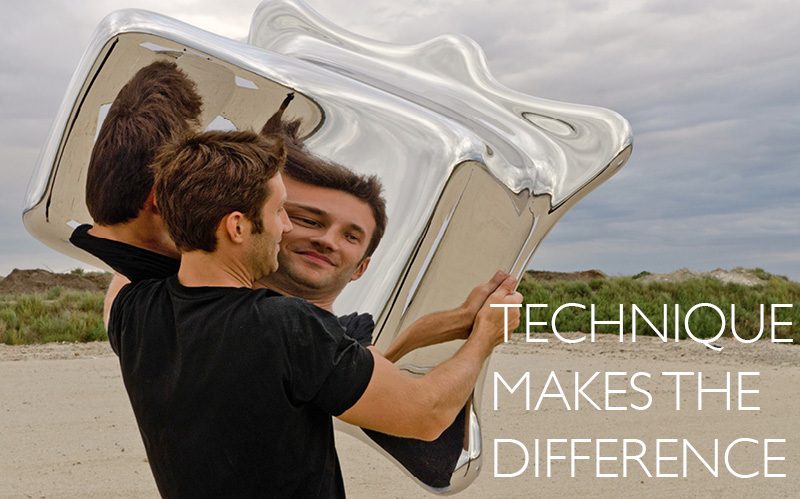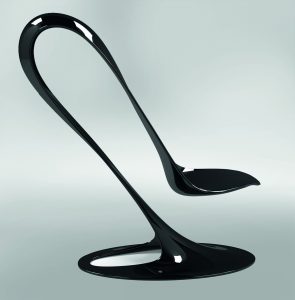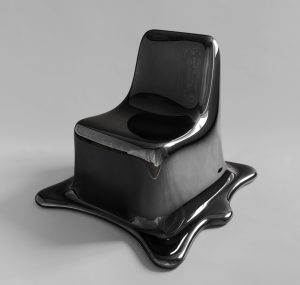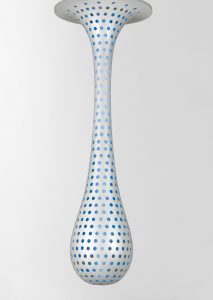
TECHNIQUE MAKES THE DIFFERENCE
His chairs have a visual resemblance to mercury. Experimental Vienna designer Philipp Aduatz has left few materials untested in his work. Some of his amorphous design pieces are offered for sale at Dorotheum’s upcoming design auction.
BY MATHIAS HARNISCH
The 34-year old Viennese designer’s love of painting was awoken early in life. Philipp Aduatz was born into an artistic family – his father was a cartoonist, his great uncle, Friedrich Aduatz, a proponent of the abstract painting movement. Some of his works have been sold through Dorotheum over the years.
Philipp Aduatz concluded his studies under Professor Paolo Piva at the Vienna University of Applied Arts in 2007 with a degree in industrial design. Aduatz’ was drawn by the concept of single-edition design from the onset – his designer role models were mainly Ron Arad, Danny Lane, Tom Dixon and Ross Lovegrove, while artistic sculpting style input was sought in the works of artists such as Richard Serra, Hans Arp, Tony Cragg and Constantin Brâncuși.
Towards the end of his studies, Aduatz became increasingly attracted to the young generation of British and Dutch designers such as Maarten Baas, Tom Price, Max Lamp and Joris Laarman – not least because he shared with them an affinity for the seamless merger of art and design.
Art and Technical Design
As soon as he had bagged his degree, Philipp Aduatz dedicated himself to the investigation of art and technical design. Straight out of school, he started manufacturing limited editions of furniture, designed and cast in a number of highly different materials. Hardly any material was left untested, be it graphite, fibreglass reinforced plastic, linen, polyester, wood, PU foam or varnish.
For the production of “Melting Chair”, Aduatz picked and tested manufacturing techniques and materials with great care to reach a unique result. The chair is made of fibreglass reinforced plastic, a light but firm material that is quite easily manipulated into complex shapes. By way of an innovative chemical reduction process, which has been in use for over 100 years, the chair’s surface is coated with a thin layer of silver and subsequently sealed with a clear varnish. Whereas the use of the customary galvanic baths for chromium plating has certain size limitations, the technique applied by Aduatz allows for silver coating of small and large objects alike. The technique is paramount to the characteristic visual appearance of Aduatz’s design work, which is notable not least due to its seemingly instantaneous capturing of material in different aggregate states. Aduatz conveys the optical Illusion of a state in between fluid and solid, distinguished by unstructured and organic curves.
Aduatz doesn’t limit himself to furniture, however, he designs lamps too.
(right: Philipp Aduatz, „Drop“ floor and hanging lamp)
He also designs unusual bathroom furniture for Klomfar’s Aquawave line. He intends, he has said, to expand his range of activity with new products and concepts in the time to come, adding for example metals, ceramics and concrete to his materials toolbox. It will be quite exciting to see what objects will emerge from these experiments.
The objects being sold at Dorotheum’s upcoming design auction on 20 June, 2017, would seem a convincing foretaste of what’s to come. As the preliminary inspection presentation will clearly demonstrate, Aduatz’s designs make an elegant and harmonious fit with the works of most other designers. His works are well under way to becoming regular design classics. They have already been included in various international design collections and made the rounds at a number of fairs and design exhibitions.
Mathias Harnisch is a specialist in Design at Dorotheum.















